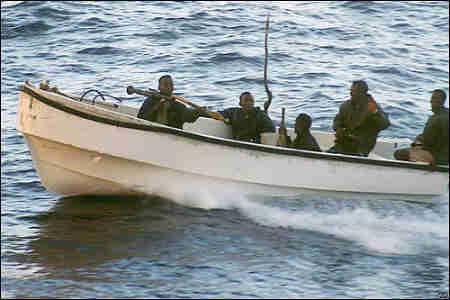Can Israel’s Lifeline To Oil Survive?
by John Konrad (gCaptain) Amidst the intense conflict with Hamas, Israel’s Eilat-Ashkelon pipeline -linking oil tanker ports on the Gulf Of Aqaba to Haifa – has emerged as a critical...


In light of the recent piracy news gCaptain has recieved a number of media requests to answer basic questions about piracy. Below you will find just a few of the questions we have been asked along with my answers.
Pirates need a few things to prosper: weak national security of a host state or political unrest, access to weapons, ships transiting close to shore, cooperative weather and an abundance of high value ships.
Somalia certainly meets the first two requirements but, like in real estate, it’s Location, Location, Location. As seen in the diagram of shipping routes below, somalia lies in the direct path of traffic transiting between Asia and the Suez canal. The manner in which Somalia just coupled with the amount of shoreline in close proximity to shipping lanes gives the pirates easy access to ships.
Traditionally pirates attack specific ships after being tipped off to valuable cargo or a safe full of cash. Their mission was to get aboard, subdue the crew and leave both quickly and quietly.
Somali pirates have a different motive and target large ocean-going ships with few items of value aboard that are easy to transport and sell ashore. The recent hijackings are instead the result of millions of dollars in ransom demands being met by shipowners and brings the number of attacks off Somalia to 91 this year. These ransoms are paid to local warlords that have many ways to encourage the pirates to take the risk. The people planning these attacks remain shoreside and have very little risk of being harmed.
Prior to the recent attacks in Somalia the most dangerous place for vessels was the Malacca Straight. The reason for this is again, Location. Situated between Malaysia and Indonesia, this 500 mile stretch of water is the shortest route for ships traveling from Asia to Europe and the Middle East. It is also narrow which allows pirates to get near vessels undetected.
Another piracy hotspot today is Nigeria. The country’s large reserve of oil offshore causes conflict between residents, the government and the oil exploring companies. Very few large vessels are pirated in Nigeria, rather, offshore instilations and smaller service vessels are often the target.
The following map shows pirate attacks worldwide in 2008. The interactive version can be found HERE.
Pirates use small and fast boats to get close to ships transiting near shore.
Shipowners are hesitent in allowing weapons aboard ship for a number of reasons.
In the last few decades ship operators have used new technology and operating proceedure to reduce the average vessel’s largest cost; personel. Most ships today operate with only one or two persons designated as lookouts while they are in open water. total compliment is usually less than 25 people. Compounding the problem is that small boats are difficult to see and often do not show up on radar. The boats can also travel at speeds much high than that of an average tanker (about 12 knots) or even a containership (25 knots)
By using boats to board large ships the pirates are bound by the range of such vessels. The more recent attacks however have taken place at distances up to 250 miles from the coast. There is evidence pirates extend the range of such trips by using mother ships. In the case of Somalia it is believed that pirates have control of a few large fishing boats that serve to ferry, house and resupply the smaller boats.
While ship owners may welcome navy protection of vessels there are political considerations taking place. It has long been the US Navy’s mission to protect the US Merchant Marine but today very few ships (even those bringing cargo to and from the United States) fly the American flag. Most ships are registered in countries like Panama, Liberia and the Marshal Islands. These countries are refered to as Flags Of Convienece and are preffered by ship owners because of less stringent rules, allowance of multi-national crews and low tax rates. Besides the registry of a vessel, ships are often owned by entities of one nationality, insured by another, crewed with officers of a third and unlicensed personel of yet another. This combination of national interest complicates the situtuation considerably.
Another theory is that naval action will not fix the underlying cause of these attacks and will not motivate ship owners to take positive action to defend their vessels. It is not until ships are crewed with a sufficeint number of lookouts, their personel are well trained and they fully impliment the latest security technology that the problem will go away.
————-
Stay tuned for Part II of this FAQ
Join the gCaptain Club for curated content, insider opinions, and vibrant community discussions.


Join the 105,914 members that receive our newsletter.
Have a news tip? Let us know.
Access exclusive insights, engage in vibrant discussions, and gain perspectives from our CEO.
Sign Up




Maritime and offshore news trusted by our 105,914 members delivered daily straight to your inbox.



Essential news coupled with the finest maritime content sourced from across the globe.
Sign Up